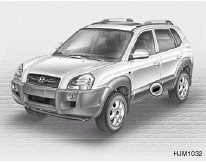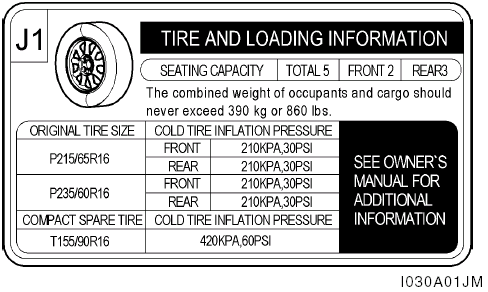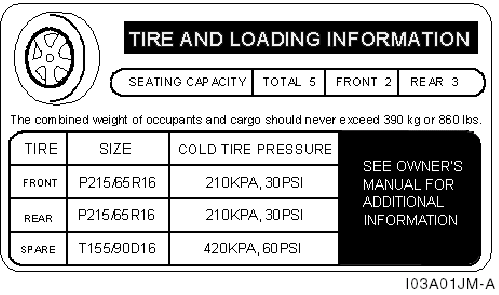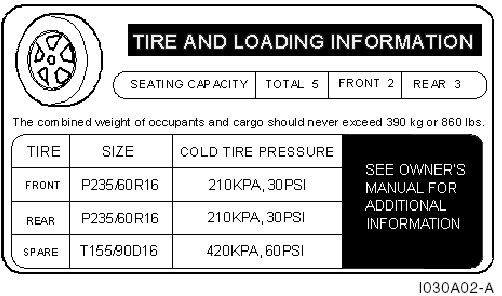 Hyundai Tucson: Recommended cold tire inflation pressures
Hyundai Tucson: Recommended cold tire inflation pressures

Tire label located on the driver's side of the center pillar outer panel gives the cold tire pressures recommended for your vehicle with the original tire size, the number of people that can be in your vehicle and vehicle capacity weight.
 Type A
Type A
 Type B
Type B
 Type C
Type C
These pressures were chosen to provide the most satisfactory combination of ride comfort, tire wear and stability under normal conditions. Tire pressures should be checked at least monthly. Proper tire inflation pressures should be maintained for these reasons:
WARNING: o Inspect your tires frequently for proper inflation as well as wear and damage. Always use a tire pressure gauge. o Tires with too much or too little pressure wear unevenly causing poor handling, loss of vehicle control, and sudden tire failure leading to accidents, injuries, and even death. The recommended cold tire pressure for your vehicle can be found in this manual and on the tire label located on the driver's side of the center pillar. o Worn tires can cause accidents. Replace tires that are worn, show uneven wear, or are damaged. o Remember to check the pressure of your spare tire. Hyundai recommends that you check the spare every time you check the pressure of the other tires on your vehicle.
NOTE: o Underinflation also results in excessive wear, poor handling and reduced fuel economy. Wheel deformation also is possible. Keep your tire pressures at the proper levels. If a tire frequently needs refilling, have it checked by your Hyundai Dealer. o Overinflation produces a harsh ride, excessive wear at the center of the tire tread, and a greater possibility of damage from road hazards.
WARNING: Overinflation or underinflation can reduce the tire life, adversely affect vehicle handling, and lead to sudden tire failure. This could rusult in loss of vehicle control and potential injury.
CAUTION: Always observe the following: o Check pressures when the tires are cold. (After the vehicle has been parked for at least three hours or hasn't been driven more than one mile (1.6 km) since starting up.) o Check the pressure of your spare tire each time you check the pressure of other tires. o Never overload your vehicle. Be especially careful about overloading if you equip your vehicle with a luggage rack. o Worn, old tires can cause accidents. If your tread is badly worn, or if your tires have been damaged, replace them.
 Tire Information
Tire Information
The tires supplied on your new Hyundai
are chosen to provide the best performance
for normal driving.
If you ever have questions about your
tire warranty and where to obtain service,
see the ...
 Checking tire inflation pressure
Checking tire inflation pressure
Check your tires once a month or more.
Also, check the tire pressure of the
spare tire.
How to Check
Use a good quality gage to check tire
pressure. You can not tell if your tires
are proper ...
See also:
Playback of MP3 Files
When a medium containing MP3 data is loaded, the
radio checks all files on the medium. If the medium
contains a lot of folders or files, the radio will take more
time to start playing the MP3 fi ...
Driving with summer tires
Observe the notes in the "Winter operation" section (). ...
Setting automatic connection of the device on or off
If “BT Power” is set to on, the registered device will be connected
automatically when the engine switch is turned to the “ACC” position.
1 Select “BT Power” using .
2 Select “ON” o ...
